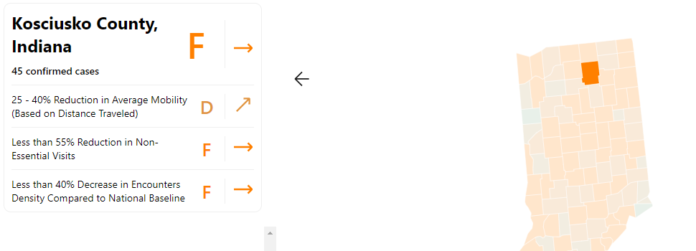
27 states in the United States received failing grades when it has come to social distancing during the course of the COVID-19 pandemic, Indiana included.
According to the study by Unacast, a company that works with location data, used information from cell phone GPS data to see how people have been moving around, making non-essential visits and encountering with other humans.
Indiana failed on all three of those points, meaning that there was a less than 25 percent reduction in average mobility, based on distance traveled, a less than 55 percent reduction in non-essential visits, and a less than 40 percent decrease in people having interactions with other people.
56 counties in the state, including Kosciusko County, also received a failing grade. Kosciusko County failed in dropping non-essential visits and human interaction, but received a “D” in average mobility, as the study showed there was a 25-40 percent reduction in travel.
Surrounding counties such as Marshall, Elkhart and Whitley Counties also received failing grades with similar marks.
Fulton County received a “D-,” failing in the travel reduction and non-essential visit categories, but received a “C” in human interaction as there was a 74-82 percent decrease in that category.
Wabash and Noble Counties also received the “D-” grade, failing to reduce non-essential visits, but slight reductions were seen in traveling (a 25-40 percent decrease) and human interaction (a 40-74 percent reduction).
22 other counties received “D” grades, 12 received “C” grades and two received “B” grades. There were no “A” grades given in Indiana.
Across the US, no state received better than a “C” grade, with Nevada, Vermont and Maine, along with the non-state entity of the District of Columbia, being the only areas receiving such a grade.
Only 18 counties in the US received an “A” grade, many of which were located in Alaska or rural regions of states. Those areas had very low case counts, but were also missing data regarding non-essential visits.
You can check out the full study and use the interactive map on Unacast’s website here.




